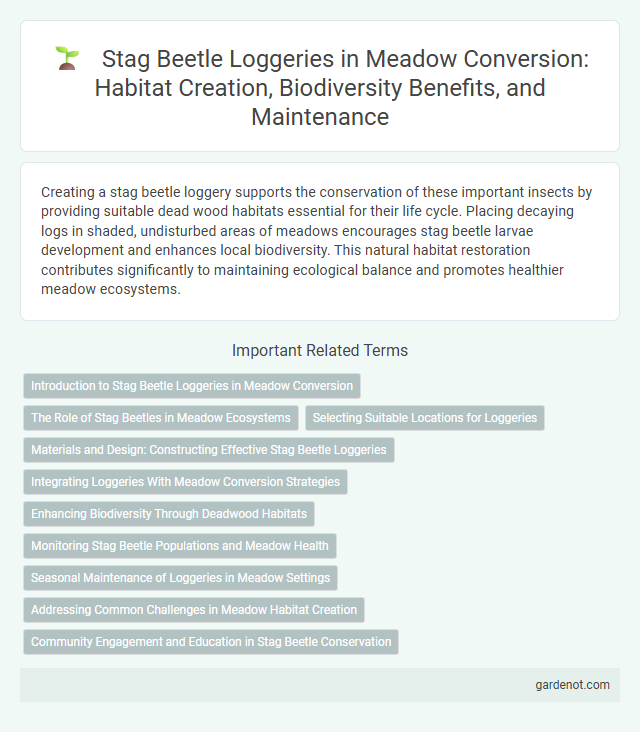Creating a stag beetle loggery supports the conservation of these important insects by providing suitable dead wood habitats essential for their life cycle. Placing decaying logs in shaded, undisturbed areas of meadows encourages stag beetle larvae development and enhances local biodiversity. This natural habitat restoration contributes significantly to maintaining ecological balance and promotes healthier meadow ecosystems.
Introduction to Stag Beetle Loggeries in Meadow Conversion
Stag beetle loggeries are essential habitats created by deadwood collections that support the lifecycle of Lucanus cervus within meadow conversions. These structures provide crucial breeding and overwintering sites, enhancing biodiversity by promoting saproxylic insect populations. Integrating stag beetle loggeries into meadow restoration efforts significantly contributes to the ecological health and sustainability of these habitats.
The Role of Stag Beetles in Meadow Ecosystems
Stag beetles play a crucial role in meadow ecosystems by aiding in the decomposition of deadwood, which enriches soil fertility and promotes nutrient cycling. Their larvae break down decaying logs, creating habitats for other organisms and supporting biodiversity within meadow habitats. The presence of stag beetle loggery enhances ecosystem resilience by maintaining healthy soil structures and facilitating plant growth.
Selecting Suitable Locations for Loggeries
Selecting suitable locations for stag beetle loggeries requires identifying deadwood areas with sufficient moisture and minimal disturbance, ideally within deciduous woodlands or hedgerows. Logs should be partially buried or placed on the ground in shaded, south-facing spots to maintain stable microclimates essential for larvae development. Proximity to mature trees increases the likelihood of stag beetle habitation while supporting local biodiversity and ecosystem health.
Materials and Design: Constructing Effective Stag Beetle Loggeries
Effective stag beetle loggeries utilize decayed hardwood logs such as oak, ash, and beech, providing essential habitat for larvae development. Logs should measure at least 30-50 cm in length and 20-30 cm in diameter to offer suitable shelter and microclimate conditions. Positioning logs partially buried in shaded, damp areas within meadows ensures moisture retention and protection from predators, optimizing stag beetle conservation efforts.
Integrating Loggeries With Meadow Conversion Strategies
Integrating stag beetle loggeries into meadow conversion strategies enhances biodiversity by providing essential habitats for these saproxylic insects. Strategically placing decaying logs within restored meadows supports stag beetle life cycles while promoting soil health and native flora growth. This approach balances habitat conservation with meadow ecosystem restoration, fostering resilient and species-rich environments.
Enhancing Biodiversity Through Deadwood Habitats
Stag beetle loggery plays a crucial role in enhancing biodiversity within meadow conversion projects by providing essential deadwood habitats that support the lifecycle of Lucanus cervus. These specialized log piles create microhabitats rich in decaying wood, fostering a diverse community of invertebrates, fungi, and microorganisms that contribute to overall ecosystem health. Integrating stag beetle loggery into meadow restoration not only preserves this flagship species but also promotes ecological complexity and sustainability.
Monitoring Stag Beetle Populations and Meadow Health
Stag beetle loggery plays a crucial role in monitoring stag beetle populations by providing essential habitats that support their life cycles within meadow ecosystems. Regular surveys of loggery sites help track population health and inform adaptive meadow management practices that enhance biodiversity. Integrating habitat monitoring with meadow conversion efforts ensures balanced ecosystem functions and promotes long-term sustainability of both stag beetles and meadow habitats.
Seasonal Maintenance of Loggeries in Meadow Settings
Seasonal maintenance of stag beetle loggeries in meadow settings involves regular inspection to remove debris and prevent fungal growth, ensuring optimal habitat conditions. Logs should be repositioned or replaced in early spring to support larval development during warmer months. Monitoring moisture levels and avoiding disturbance during the beetle's active periods maximizes conservation success.
Addressing Common Challenges in Meadow Habitat Creation
Stag beetle loggery plays a crucial role in meadow habitat creation by providing essential deadwood habitats necessary for larval development, addressing the common challenge of deadwood scarcity in managed landscapes. Incorporating loggery structures enhances biodiversity, supporting not only stag beetles but also a wide range of invertebrates associated with decaying wood. Effective placement and maintenance of stag beetle loggery helps overcome habitat fragmentation and ensures the long-term sustainability of meadow ecosystems.
Community Engagement and Education in Stag Beetle Conservation
Stag beetle loggery projects play a crucial role in community engagement by providing hands-on opportunities for citizens to participate in conservation efforts, enhancing local awareness of beetle habitats. Educational programs centered on stag beetle loggery inform schools and community groups about the species' ecological importance, fostering stewardship and support for habitat preservation. Collaboration between conservationists and volunteers in loggery construction and monitoring strengthens community ties and promotes long-term commitment to stag beetle conservation.
Stag beetle loggery, Infographic

 gardenot.com
gardenot.com